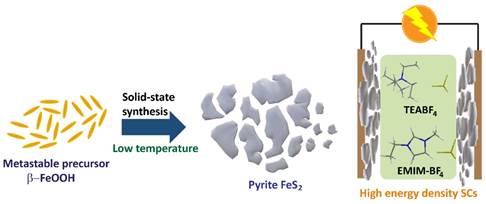New Delhi, October 5, 2023 – In a groundbreaking development, researchers at the Centre for Nano and Soft Matter Sciences in Bengaluru, under the aegis of the Department of Science & Technology, have achieved a remarkable feat in the field of energy storage technology. They have successfully synthesized highly crystalline pyrite (FeS2) at low temperatures, paving the way for the creation of high energy density supercapacitors (SCs) and revolutionizing the future of energy storage.
Transition metal sulfides (TMS) have long been a crucial category of inorganic materials with applications spanning various fields, including electrochemical energy storage devices such as batteries and supercapacitors. Traditionally, these materials have been generated through solid-state synthetic methods, involving the conversion of metal salts or their equivalent oxides, typically at high temperatures.
However, the breakthrough achieved by Ms. Savithri Vishwanathan, under the expert guidance of Dr. H. S. S. Ramakrishna Matte, has rewritten the rules of synthesis. Their pioneering work involves the low-temperature synthesis of crystalline pyrite FeS2, a feat previously considered unattainable using solid-state synthesis techniques. The key to this accomplishment lies in the utilization of a metastable oxyhydroxide (FeOOH) precursor.
The team managed to stabilize this intermediate oxyhydroxide and employ it as a precursor for sulfidation, in the presence of H2S gas, marking a significant scientific milestone. This groundbreaking approach was documented in their research paper published in the esteemed journal Chemical Communications.
The use of a metastable precursor has been instrumental in reducing the annealing temperature, as FeOOH is transformed into pyrite FeS2 with exceptional crystallinity, all at a significantly lower temperature than conventional methods. This breakthrough opens the door to the possibility of obtaining crystalline materials from their corresponding metastable oxyhydroxides, effectively reducing the energy consumption associated with their production.
The impact of this achievement extends to the realm of energy storage, where the synthesized FeS2 has been used to create electrodes for high-energy density supercapacitors. The results have been nothing short of remarkable. These FeS2-based electrodes have demonstrated superior performance when exposed to organic and ionic-liquid (IL)-based electrolytes. This enhanced performance can be attributed to the material’s exceptional crystallinity, which significantly improves conductivity, and its enhanced wettability in the presence of organic and IL-based electrolytes. As a result, the FeS2 electrodes have exhibited both high energy and power densities, marking a significant stride in the field of energy storage technology.
This breakthrough not only promises to revolutionize the energy storage landscape but also highlights the role of innovative synthetic procedures in enhancing electrochemical properties. As the world seeks more efficient and sustainable energy storage solutions, this research paves the way for a future where high energy density supercapacitors play a pivotal role in meeting our growing energy demands.
In conclusion, the synthesis of highly crystalline pyrite FeS2 at low temperatures is a testament to the indomitable spirit of scientific exploration and innovation. The researchers at the Centre for Nano and Soft Matter Sciences have shown that even seemingly insurmountable challenges can be overcome with determination and ingenuity. This breakthrough brings us one step closer to a greener and more energy-efficient future.
KeyFacts
🧪 Researchers at the Centre for Nano and Soft Matter Sciences, Bengaluru, synthesized highly crystalline pyrite FeS2 at low temperatures.
🔋 The synthesized pyrite is used for making electrochemical energy storage devices like batteries and high energy density supercapacitors (SCs).
🔬 They employed a solid-state synthesis route using a metastable oxyhydroxide (FeOOH) precursor.
🌡️ This process lowered the annealing temperature, making it energy-efficient.
📈 The FeS2-based electrodes demonstrated superior performance in the presence of organic and ionic-liquid-based electrolytes.
🔌 This achievement highlights the potential for enhancing electrochemical properties in energy storage.
📚 The research is published in the journal Chemical Communications.
Also read UPSC Announces Results for Combined Defence Services Exam (II)-2023
Frequently Asked Questions (FAQs)
- What is pyrite FeS2, and why is it important in energy storage? Pyrite FeS2 is a mineral with great potential for energy storage applications due to its exceptional crystallinity and conductivity.
- How does low-temperature synthesis benefit energy storage technology? Low-temperature synthesis reduces energy consumption and opens up new possibilities for creating high-performance energy storage materials.
- What are supercapacitors, and how do they differ from batteries? Supercapacitors are energy storage devices that can deliver rapid bursts of energy, making them ideal for applications requiring high power output. Batteries, on the other hand, store energy for longer durations.
- What role does the Department of Science & Technology play in this research? The Department of Science & Technology provides support and resources for scientific research and innovation in India.
- How might this breakthrough impact renewable energy storage? This breakthrough could lead to more efficient and cost-effective energy storage solutions for renewable energy sources, making them more accessible and reliable.
Stay Updated | UPSC Announces Results for Combined Defence Services Exam (II)-2023
- Follow us on Facebook , Telegram and Twitter for the latest Education News updates and Daily Current Affairs
- Subscribe to our website for more updates on upcoming exams and results.
- Check all open Government Jobs 2023 Here
























